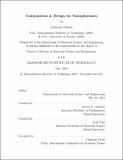Computation & design for nanophotonics
Author(s)
Oskooi, Ardavan F
DownloadFull printable version (7.911Mb)
Alternative title
Computation and design for nanophotonics
Other Contributors
Massachusetts Institute of Technology. Dept. of Materials Science and Engineering.
Advisor
Steven G. Johnson and Yoel Fink.
Terms of use
Metadata
Show full item recordAbstract
The versatility of computational design as an alternative to design by nanofabrication has made computers a reliable design tool in nanophotonics. Given that almost any 2d pattern can be fabricated at infrared length scales, there exists a large number of degrees of freedom in nanophotonic device design. However current designs are adhoc and could potentially benefit from optimization but there are several outstanding issues regarding PDE-based optimization for electromagnetism that must first be addressed: continuously and accurately deforming geometric objects represented on a discrete uniform grid while avoiding staircasing effects, reducing the computational expense of large simulations while improving accuracy, resolving the breakdown of standard absorbing boundary layers for important problems, finding robust designs that are impervious to small perturbations, and finally distinguishing global from local minima. We address each of these issues in turn by developing novel subpixel smoothing methods that markedly improve the accuracy of simulations, demonstrate the failure of perfectly matched layers (PML) in several important cases and propose a workaround, develop a simple procedure to determine the validity of any PML implementation and incorporate these and other enhancements into a flexible, free software package for electromagnetic simulations based on the finite-difference time-domain (FDTD) method. Next we investigate two classes of design problems in nanophotonics. The first involves finding cladding structures for holey photoniccrystal fibers at low-index contrasts that permit a larger class of materials to be used in the fabrication process. The second is the development of adiabatic tapers for coupling to slow-light modes of photonic-crystal waveguides that are insensitive to manufacturing and operational variability.
Description
Thesis (Sc. D.)--Massachusetts Institute of Technology, Dept. of Materials Science and Engineering, 2010. This electronic version was submitted by the student author. The certified thesis is available in the Institute Archives and Special Collections. Cataloged from student submitted PDF version of thesis. Includes bibliographical references (p. 191-209).
Date issued
2010Department
Massachusetts Institute of Technology. Department of Materials Science and EngineeringPublisher
Massachusetts Institute of Technology
Keywords
Materials Science and Engineering.